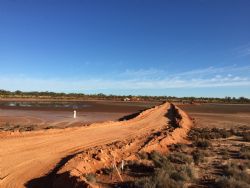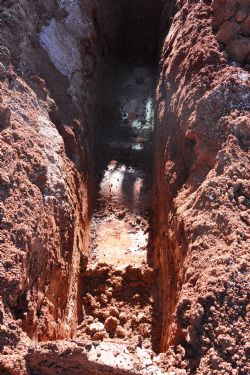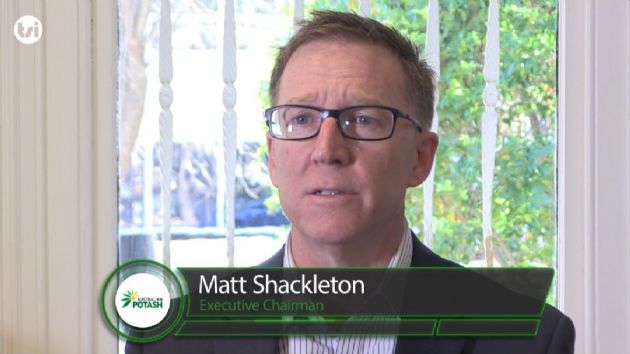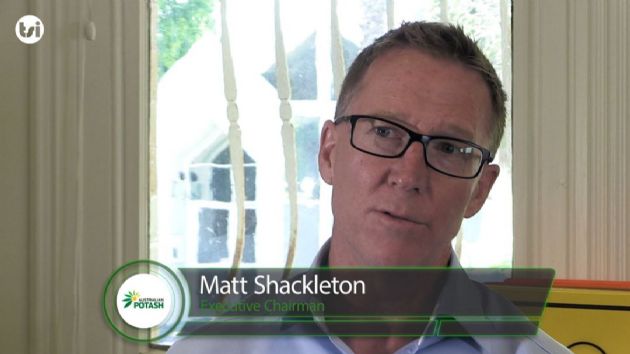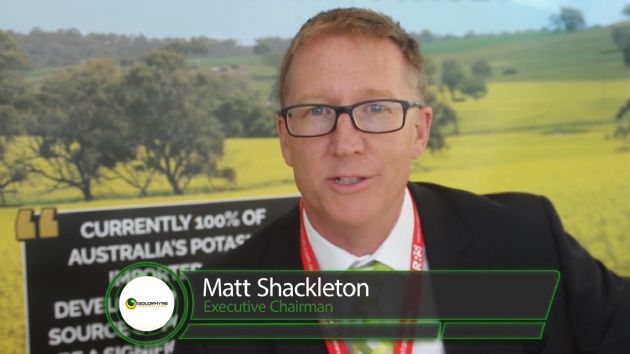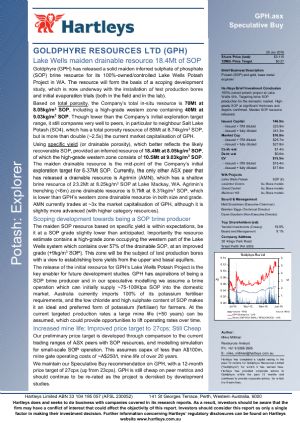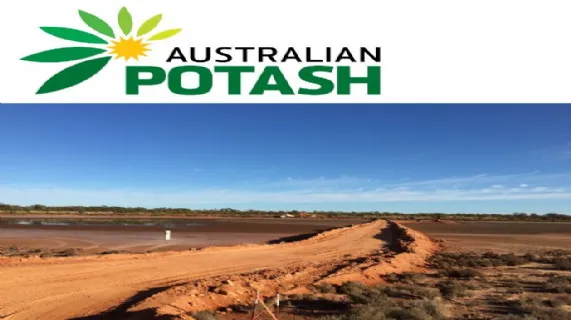
Evaporation Pond Program and Project Update
Perth, April 29, 2019 AEST (ABN Newswire) - Australian Potash Limited ( ASX:APC) (APC or the Company) is pleased to advise on the progress of the pond constructability program of work in the Definitive Feasibility Study (DFS) of the Lake Wells Sulphate of Potash Project (Project). The program will complete in June 2019. The Company also provides an update on the status of several DFS work streams.
ASX:APC) (APC or the Company) is pleased to advise on the progress of the pond constructability program of work in the Definitive Feasibility Study (DFS) of the Lake Wells Sulphate of Potash Project (Project). The program will complete in June 2019. The Company also provides an update on the status of several DFS work streams.
Highlights:
- Evaporation pond construction program commenced at Lake Wells to assess optimum commercial scale pond construction technique
- Program conclusion to identify the most cost efficient technique that will feed into the Lake Wells Potash Project Definitive Feasibility Study
- Diamond drilling progressing at site to assess bed-rock permeability properties
- Bore development rig has commenced final drilling program to complete updated resource model with test-pumping program to commence immediately thereafter
Managing Director and CEO, Matt Shackleton, commented: "Prior to the construction of fullscale commercial evaporation ponds, we need to confirm the most economically and technically optimal construction method for the pond walls - Stage 1 ponds will be approximately 10km2 in area making data gathered in this program vital to future development.
"We know we can take advantage of the surface clay layer to seal the bottom of the ponds: what we are assessing is which is the best wall construction technique to seal the walls of the ponds. We call these On-playa Trial Ponds, as they are built unlined, on the lake surface.
"This program is one of the final two field programs underway to complete the Definitive Feasibility Study data set - the other is the long term test-pumping program on production wells. By the conclusion of the DFS, we will have installed and pump-tested approximately 30% of our Stage 1 bore-field, allowing APC to move seamlessly into pond fills on development."
TECHNICAL DISCUSSION
The Lake Wells Potash Project will include over 10 km2 of On-playa evaporation ponds. As a continuous flow process, these 'pre-concentration' ponds will promote the precipitation of halite (NaCl) while increasing the concentration of potassium (K) and sulphate (SO4) in the brine. The low permeability clay layer near the surface of Lake Wells provides an excellent barrier to minimise vertical seepage of the brine and APC intends to integrate the overlying 'Kopai' dunes - largely cemented sand - as pond embankments. However, installation of a vertical, sub-surface barrier to minimise lateral seepage below the dunes must be constructed. As part of the on-going Definitive Feasibility Study (DFS), APC, through its consulting geotechnical engineers Knight Piésold, have completed numerical modelling to assess seepage in both transient and steady states. While the modelling indicates that overall brine loss due to seepage is low, it is imperative to assess barrier designs in the field to improve confidence on constructability and design economics. As such, APC is constructing an On-playa Trial Pond (Trial Pond).
The On-playa Trial Pond will assess the constructability, efficacy and economics of three subsurface, vertical barrier designs while also assessing constructability of an on-playa causeway using local borrow material. The On-playa Trial Pond is constructed in a 'lagoon', creating a semi-circular pond shape with a causeway across the diameter and using the surrounding dune as a perimeter embankment to construct the sub-surface barriers.
The On-playa Trial Pond is constructed in proximity to an existing brine production bore which will undergo test pumping to add to the aquifer resource model. Brine discharged from the production bore will be contained within the On-playa Trial Pond. Stand-pipe piezometers will be installed around the On-playa Trial Pond to measure pore water pressure in response to pond filling and to assess seepage through the barriers. The On-playa Trial Pond will be constructed by early May and brine discharge will follow shortly thereafter. Monitoring will continue through June.
Geotechnical
Between 2016 and 2017, geotechnical investigations of the Lake Wells area were completed. The work included:
- More than 100 test pits and adjacent dynamic cone penetrometer tests;
- 140 cone penetrometer tests with pore water pressure measurements;
- Diamond drilling;
- Hand augering;
- Bulk and undisturbed soil sampling for laboratory testing; and,
- Falling head permeabilty tests.
These investigations provided the basis for the on-playa (pre-concentration) and off-playa (harvest) evaporation pond layouts. In 2018, geotechnical engineers, Knight Piesold (KP), were engaged to advance the pre-concentration pond design in conjunction with Novopro Projects (Novopro), the Montreal-based, solar salt processing experts. KP completed hydraulic models, and steady-state and transient seepage analyses, which contribute to Novopro's evaporation and brine chemistry models to develop pond size and configuration. Seepage containment designs modelled by KP are being analysed in this trial pond program.
PROJECT UPDATE
Resource
Subsequent to reporting the JORC 2012 compliant Indicated Mineral Resource(see Note 1 below) in March 2017, significant additional work has been completed, enhancing APC's understanding of the resource. Drilling, passive seismic surveys, brine assays, and particle size distribution tests have been completed, adding significant confidence in, and indicating a potential expansion of, the resource. Areas where the resource is likely to be increased include the central area (that was not held by APC at the time of the Scoping Study but has since been acquired) and further extensions in the south-west of the project area.
Additional drilling has totaled 3,180m and includes two production bores completed since the calculation of the reported Resource.
A further 52,600m of passive seismic data has been generated, which contributes to the understanding of the Lake Wells palaeovalley model, and has facilitated identification of drill targets for the current program.
Two or three large diameter production bores will be completed along with associated monitoring bores to assess aquifer response during pumping.
The level of detail in the original Resource model, combined with the additional data collected in the last two years lends APC a high degree of confidence in its Resource estimate. The Company looks forward to reporting a Resource expansion as a result of the upcoming work. Increasing resource confidence aligns with the JORC code (see Figure 2 in link below) where both geological knowledge has increased along with accuracy of the modifying factors developed through the DFS.
Pump Testing
Successful long-term pump testing was conducted at Lake Wells in 2017(see Note 2 below) and additional tests will be conducted at several different locations to confirm the observations recorded previously, and finalise the Reserve estimate.
In groundwater analysis, aquifer response is a function of the log of time and not linear time.
For example, a 20 year pumping project comprises 10 million minutes of pumping while a 30 day pumping test comprises approximately 40 thousand minutes. On a linear scale this pump-test time is relatively minor in comparison to the total LOM pumping time.
However as aquifer response is not measured in linear time, but responds in a logarithmic fashion, a 30 day pump-test is equivalent to 65% of mine life for a 20 year LOM project, when viewed on log time.
The Australian brine SOP projects and those similar style, overseas lithium brine projects that are proposing to source their brine using a bore-pumping system use the same understanding of aquifer response scales to assess their aquifer production capabilities.
Evaporation, Precipiation and Processing
HDPE-lined, off-playa, pilot evaporation ponds were constructed and filled with Lake Wells Paleochannel brine in late 2017. Over the course of 2018, evaporation and salt crystallisation in the pilot ponds were monitored and recorded against the Novopro models. Following adequate evaporation and crystallisation in the pilot pre-concentration pond, the concentrated brine was transfered between the pilot harvest ponds to produce the potassium (K) and sulphate (SO4) bearing salts, as predicted in the numerical models. More than 20 tonnes of salts were produced as a result of the pilot evaporation program and more than three tonnes of these salts were delivered to Bureau Veritas in December 2018 to commence the pilot processing program. The pilot process was designed by Novopro, following the process flowsheet developed for the project. The delivered salts underwent assay and XRD analysis before processing preparation; more than 250 kg of high-quality Sulphate of Potash (SOP) was produced in January 2019.
The Novopro process design, including flowsheets, mass balance, specifications and data sheets, is complete and was handed over to Lycopodium Minerals Ltd (Lycopopdium). Lycopodium is now completing the DFS plant design, capital and operating costs estimates, and implementation plan. A risk assessment will be completed with participation of all technical consultants as part of the DFS.
Environmental
The Project was referred to the Environmental Protection Authority (EPA) in December 2017 and it was determined that the Project would be formally assessed, through an Environmental Review Document (ERD), in February 2018. An Environmental Scoping Document was approved and published by the EPA in September 2018.
To inform the development of the ERD and DFS, APC have completed several studies and baseline surveys within and adjacent to the salt lake system, including terrestrial fauna, subterranean fauna, and flora. In addition to fauna and flora assessments, the ERD will include the groundwater abstraction plan. While also substantiating the resource and reserve models, the upcoming drilling and pump testing work will also contribute significantly to validating the water management plan as part of the ERD.
Notes:
1 Refer to ASX announcement 23 March 2017 'Scoping Study Confirms Exceptional Economics of APC's 100% Owned Lake Wells Potash Project In WA'. That announcement contains the relevant statements, data and consents referred to in this announcement. Apart from that which is disclosed in this document, Australian Potash Limited, its directors, officers and agents: 1. Are not aware of any new information that materially affects the information contained in the 23 March 2017 announcement, and 2. State that the material assumptions and technical parameters underpinning the estimates in the 23 March 2017 announcement continue to apply and have not materially changed.
2 Refer to ASX announcement 21 November 2017 'Pumping Test Confirms Drainage from Entire Palaeochannel Sequence into Basal Production Aquifer'. That announcement contains the relevant statements, data and consents referred to in this announcement. Apart from that which is disclosed in this document, Australian Potash Limited, its directors, officers and agents: 1. Are not aware of any new information that materially affects the information contained in the 21 November 2017 announcement, and 2. State that the material assumptions and technical parameters underpinning the estimates in the 23 March 2017 announcement continue to apply and have not materially changed.
To view figures, please visit:
http://abnnewswire.net/lnk/FR2O52I5
About Australian Potash Ltd
Australian Potash Limited (ASX:APC) is an ASX-listed Sulphate of Potash (SOP) developer. The Company holds a 100% interest in the Lake Wells Potash Project located approximately 500kms northeast of Kalgoorlie, in Western Australia's Eastern Goldfields.
Following the release of a Scoping Study in 2017, APC has been conducting a Definitive Feasibility Study (DFS) into the development of the Lake Wells Potash Project. The Company is aiming to release the findings of the DFS in H2 2019.
The Lake Wells Potash Project is a palaeochannel brine hosted sulphate of potash project. Palaeochannel bore fields supply large volumes of brine to many existing mining operations throughout Western Australia, and this technique is a well understood and proven method for extracting brine. APC will use this technically low-risk and commonly used brine extraction model to further develop a bore-field into the palaeochannel hosting the Lake Wells SOP resource.
A Scoping Study on the Lake Wells Potash Project was completed and released on 23 March 2017. The Scoping Study exceeded expectations and confirmed that the Project's economic and technical aspects are all exceptionally strong, and highlights APC's potential to become a significant long-life, low capital and high margin sulphate of potash (SOP) producer.
| ||
|





